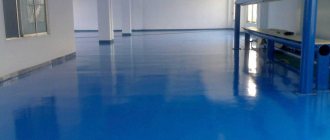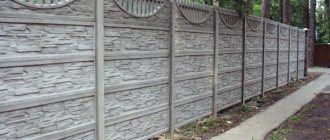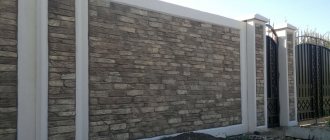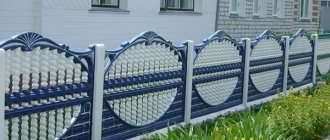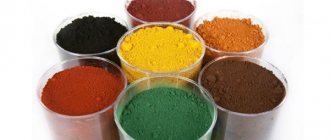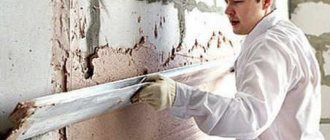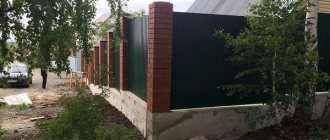Concrete fencing is common among private landowners. Its service life and durability primarily depend on the quality of manufacturing. But one cannot ignore the factor of atmospheric influence:
- precipitation;
- wind erosion;
- change in heat flow;
- city emissions and more.
Over time, microcracks and chips appear on the surface. The color fades and the fence becomes dirty.
Painting a concrete fence helps reduce the negative impact.
Need for coverage
Concrete is a stone-like substance with a porous structure. Because of this, intense water absorption occurs. During the cold season, moisture crystallizes into ice, which expands and destroys the integrity of the product.
Temperature changes can cause internal thermal stress. A sharp change in values on the surface and inside the concrete creates the preconditions for the occurrence of cracks. A similar phenomenon is observed in mountainous areas - rocks are destroyed due to solar heating during the day and cooling at night.
Painting operations help prevent excessive water absorption, increase reflectivity, and increase aesthetic appeal - the concrete fence must be painted.
Why paint concrete
Concrete is undoubtedly one of the most durable and long-lasting materials.
Especially when it comes to highly standardized composition. However, even a frozen solution of the highest quality is characterized by porosity.
The pores of concrete are large enough to allow moisture, air, ultraviolet radiation, bacteria, moss spores, reagents and fungi to penetrate into them.
The more unfavorable factors in the region of operation, the faster the aging of the material occurs.
Thus, climate and everyday environment greatly influence the rate of destruction of a concrete fence. There is a need to create a “barrier” to aggressive influences. Paint fulfills this role quite successfully.
The paint coating prevents negative consequences in the form of:
- cracks due to swelling from water;
- chipping after freezing;
- thickets of moss, lichen;
- fungal white and black spots;
- surface crumbling from constant moisture;
- deposits of salts, sulfur, carbon compounds.
The protective layer significantly extends the life of the fence and preserves its beauty longer. That is why concrete painting is necessary to complete construction using European technology.
In addition, without color this material looks dull and gray. Adding color will diversify the look of the area and add bright colors.
With the help of painting, you can even change the texture by simulating stone on the surface, drawing a picture or some kind of pattern. This finish gives the architectural style a touch of completeness.
Fencing inspection
The condition of the concrete fence is determined by visual inspection. Light tapping on the surface is allowed to identify cracks, peeled layers of the previous coating or the concrete itself.
The color change can be seen when analyzing the illuminated and shadowed sides of the fence. For example, the southern one, illuminated by the sun, burns out more strongly than the northern one.
Pollution is more strongly formed in the surface zone, from raindrops knocking out soil particles or wind blowing dust. An additional negative factor is the location along a busy highway.
Materials and tools for work
Before you start painting the foundation of a cement house, you should prepare everything you need.
To apply paint you will need:
- different brushes and rollers with bristles, as they are more resistant to wear from contact with concrete;
- wire brush, water hose;
- shovel;
- individual protection means.
To prepare the surface for painting, you will need cement to seal cracks and chipped areas. In addition, it is necessary to prepare a primer mixture to reduce the absorption of the concrete surface, thereby reducing paint consumption.
You will also have to decide what is the best way to paint the foundation of the house, calculate the need for a paint composition, taking into account the characteristics of the material and its approximate consumption.
Preparatory activities
The preliminary stage is necessary to create the ability to perform the main task - protecting the concrete fence by coating it with paint and varnish.
Preparation consists of several substages:
- Step 1. Cleaning from contaminants. It is done with a metal brush and a spatula-scraper. The operation is performed manually or with a mechanical tool (drill, grinder, sandblasting machine). Loose parts of the fence surface are removed. If possible, it is advisable to rinse the surface with a strong stream of water with the addition of detergents or cleaning agents.
- Step 2. The damaged surface is repaired and cracks are sealed. Cement mortar is used, ready-made or made independently. In the latter case, the proportions of cement and sand are 1:3 (in weight units). Water is added until the mixture becomes creamy (like toothpaste).
- Step 3. The smooth surface is roughened. An abrasive flap wheel (for a small area) or a sandblasting device is used.
- Step 4. Areas affected by mold or mildew are treated with an antiseptic. The substance must be difficult to wash out and used for outdoor work.
- Step 5. Metal protruding parts are coated with a rust preventative or painted with a “3 in 1” primer-enamel (rust converter-metal primer-enamel).
- Step 6. The final preparatory operation is concrete impregnation. The primer is applied with a roller (on a flat surface). In hard-to-reach places, junctions of adjacent surfaces, and corners, use a paint brush. The composition should be used for external work (facade group), and have the property of deep penetration.
Primer washed off
The impregnating composition is necessary for:
- Filling concrete micropores with a moisture-resistant polymer. This reduces paint consumption.
- Increased adhesion. The new coating enhances its adhesion properties to the surface being painted.
- Bonding of fragile chalking solid microelements remaining after cleaning and repair operations. Removing dust residues.
Impregnating compositions are available in finished form or concentrated. The main components are acrylic polymers, silicone, antiseptics, water or organic solvents. The main requirement is the possibility of using it for outdoor work (on the street).
ADVICE. It is advisable to select a primer with the same composition as the base paint. That is, acrylic paint is an acrylic primer. An organic solvent-based coating is an impregnating composition with a similar chemical substance.
What does painting give?
The main raw material for concrete structures is high-quality cement with the addition of various plasticizers, sand, and water. They are obtained by casting in different forms.
The natural color of the finished blocks is gray and inconspicuous. Therefore, in order to also decorate the area from the fence, many owners resort to painting.
An important condition when choosing a color is compatibility with other buildings, the roof of the house on the estate.
The painted surface is well protected:
- From moisture. The product forms a film, which prevents moisture from penetrating the structure of the material and acting destructively on it.
- From the formation of moss and mold. Constant exposure to precipitation creates a favorable environment for the development of microorganisms.
- From the frost. Namely, cycles of freezing and freezing. The paint prevents moisture from penetrating into the concrete, maintaining the original strength of the material.
- From the formation of surface microcracks. Priming and painting help maintain the integrity of the coating longer.
Builders recommend painting a concrete fence 1-2 months after installation, since during this period the structure will undergo the necessary shrinkage.
The best time for such work is dry spring days, when the air temperature is at least + 5 degrees and there is no extreme heat yet.
Coloring
The process of painting a reinforced concrete fence is divided into a number of technological operations:
- Choosing a coating method.
- Determination of the properties of paint for concrete fences used outdoors, types of paints and varnishes.
- Selection of dye.
- The actual painting of the fence.
Methods
Options for common painting methods recommended when using your own efforts:
- Application using a roller. The method is applicable on a surface that has a fairly flat plane, without a large number of small parts. Curvature and smooth bends are allowed. A significant disadvantage is the high cost of human effort for large volumes of work and the inability to work on shaped elements.
- Using a paint brush. The method is good for small areas. The tool is convenient for painting small parts, bends, and junctions of adjacent surfaces. Disadvantage: excessive consumption of paints and varnishes.
- Sprayer (spray). The method is characterized by high productivity and saving of raw materials. You can use industrial equipment, a hand blower, or use a spray attachment on a vacuum cleaner. The method allows you to paint all types of concrete fence surfaces, including intricate architecture. An important note is that the consistency (thickness, fluidity) of the paint must meet the requirements for liquid compositions.
ADVICE. The width of the paint roller should be 180~250mm, and the pile height should be at least 18~22mm.
Treating wood surfaces in winter
If the need to protect a wooden fence arose in winter, the choice of means will be limited. Paints such as styrene-acrylic or latex are suitable. They are resistant to low temperatures.
But the order of application is somewhat unusual:
- Half of the paint is mixed right outside.
- The second part is in a warm room.
This combination of solution temperatures, according to manufacturers, ensures strong adhesion of the paintwork to wood.
What paint to paint a concrete fence
The main requirement for paints and varnishes is the ability to be used outdoors. The paint must withstand the effects of harmful factors from the external environment:
- be moisture-resistant and moisture-resistant;
- have certain strength and plastic characteristics to withstand mechanical stress, including wind load (wind erosion);
- not to be destroyed by temperature changes for a short time (days);
- have a wide operating temperature range: from -50 to +70~80°C;
- not have a negative impact on the environment, be harmless to humans and animals;
- be vapor permeable;
- have the opportunity for wet cleaning.
Types of coatings, manufacturers
All coatings for concrete fences belong to the group of facade paints. Examples can be seen using samples from different manufacturers:
- Caparol. Produces water-based paints and varnishes for exterior use with the addition of acrylic, latex or silicone polymers. The coating has a matte or silky-matte sheen. It is highly resistant to weathering and wear-resistant. Contains antiseptic additives. Examples: Alpina MegaMax Universal, Alpina MegaMax Fassade, AmphiSilan Plus.
- Dufa. The concern, which opened production in Russia, produces:
- Water-dispersion paint FASSADENFARBE RD90. Acrylic latex base. Creates a weather-resistant coating. Alkali resistant. It withstands the aggressive environment of industrial cities well.
- Retail FASSADENWEISS. Facade water-dispersion paint to form a weather-resistant coating on a concrete base. Elastic, dries quickly.
- Düfa Siloxane Premium series. The group of acrylic-siloxane coatings has good adhesion. It has water-repellent properties and weather resistance.
- Tikkurila. Represents paint and varnish materials for concrete:
- Base paint Yki. Forms an alkali-resistant coating on an acrylate base. Has good resistance to mechanical stress. From here, it is available for cleanup activities.
- Euro Façade Plus. Acrylic facade paint with silicone additive. Prevents the growth of mold and mildew. Has water-repellent properties.
- VGT. Completely domestic enterprise. Produces:
- Exterior paint for tinting. The base is an acrylic composition in an aqueous environment. Used on concrete, plaster, wood. Lightfast. Creates a “breathable” coating.
- VD-AK 1180. Super white, breathable, with good weather resistance and apple aroma. Tinted.
- NOVA. The following brands are produced under the brand name:
- Optima. Matte acrylic copolymer based paint.
- Silicone PRO. Acrylic-based coatings with the addition of silicone polymer.
- ArtFASAD. Contains fungicidal additives to combat fungus and mold.
Not all manufacturers are represented - in fact, there are many more of them, as well as types of coatings:
- Silicon (silicate). It is based on compounds of silicon and sodium. They are not affected by biological factors and are weather-resistant. They have excellent adhesion, but are subsequently very difficult to remove. A variety is polysilicon (ash) compositions (silicon resins are introduced).
- Rubber. Forms a durable elastic water-repellent film on the concrete surface. Suitable for wood, metal, slate, plasterboard, brick. It is based on polyacrylic resins, antifreeze, and preservatives. Solvent – water. Service life more than 10 years. Despite the rather high cost, it is becoming increasingly widespread among private consumers.
- Cement. Produced in the form of dry powder. The binder is white Portland cement. They are tinted. Inexpensive. Resist the negative effects of harmful impurities in the urban atmosphere.
- Oily. They combine a group of paints based on drying oil or pentaphthalic resins. They have good adhesion. Weather resistant. Available in various colors. Inexpensive. But the service life is limited to 2~5 years - the decorative film shrinks, cracks, and peels off from the base.
- Calcareous. It is based on a composition of water and slaked lime. The cheapest option. But, the lifespan in summer is no more than two months. In cold weather - up to six months. It is advisable to use the composition to create a temporary coating. Before applying other paint, it is better to wash off the lime.
Coating color
A concrete fence is one of the first elements on the site that catches your eye. Therefore, the choice of paint and color shades must be made in advance:
- Preference should be given to calm pastel colors: beige, sand. Green or gray-blue colors look good.
- The color of the roof and fence is in harmony with each other.
- The lower part (ground) is painted in a darker shade.
- The matte coating hides defects on the fence surface due to the dispersion of the light flux.
- Tinted textured paint increases the aesthetic appeal - this gives the elements of a concrete fence a decorative effect.
- “Stone”, “brick” or decorated with flowers surfaces are emphasized by natural shades: gray, clay, red brick, bright greens.
ADVICE. It is better to order tinting from the seller - this will ensure uniformity of the composition and improve the quality of dyeing by maintaining a single color shade.
The dye, as well as the main coating, must be weather-resistant and not fade from exposure to solar radiation.
Recommendations for selection
- It is necessary to correctly determine the expected service life of the protective coating depending on external loads - urban or rural conditions, air pollution from industrial emissions and dust saturation.
- Determine the economic efficiency of the purchased paint according to the criterion “price per kg - hiding power - service life”.
- The need for periodic wet cleaning - the coating must have moisture-repellent properties.
- Alkali resistance - the paint resists city emissions or car exhaust.
- Focus on the front (front) side of the fence. As a rule, it is located next to the entrance to the site (house). Therefore, you should not greatly sacrifice the characteristics of the paint to save money.
- A concrete fence wall that is opposite or located outside the observation zone can be painted with less expensive paints and varnishes.
Tips for choosing colors
Choosing a color is an action subject to individual taste.
Sometimes the solution becomes limited due to the palette of a particular type of paint. But in general, the owner of the fence can choose any shade. In the field of professional designers, there are certain rules for selecting the color of the fence. They are highlighted in order to avoid awkward appearance and unnecessary shifts in emphasis.
The basic principles are as follows:
- Maximum 3 colors. This applies to both creating patterns and mixing shades. The main color is complemented by the second, according to the proportions, and diluted with the third by no more than 10%.
- Muted shades. The best solution would be a natural shade (brown, sand, gray, beige, khaki). If other colors are used, they should be in a dusty version without flashy notes. This is especially true for imitation stone or brick. Green tones look ideal with a large number of plants on the site.
- Rule of colorless paint. Colorless coatings are only suitable for perfectly smooth hedges. Excess shine will highlight flaws.
- Solid color with roof. Fences painted the same color as the roof look most advantageous. This combination creates visual harmony.
- White color rule. White paint will easily become the main color for any palette. In addition, it is ideal for decorative elements of any fence.
- Dark color rule. It is better to paint the upper and lower parts of the fence in darker colors. This creates the correct volume without distortion.
- Plot size rule. The smaller the area, the lighter the fence is needed. This will expand the space and avoid the “box” feeling.
The only justified case for bright paint on the fence, according to the designers, lies in the too gray, unfinished facade of the building.
It is always better to leave paint tinting to professionals.
Application of paintwork, stages
The method of painting a concrete fence with your own hands is no different from painting the walls of a building. The façade paint is applied after the primer has dried (after 1~3 hours). The tools used are a paint brush or roller. Large areas of concrete are sprayed.
The dyeing process is carried out in low windy weather. Atmospheric humidity should not exceed 60~70%. That is, there are small clouds in the sky, there is no or a light breeze. The best time is late spring, early summer.
The number of layers applied is determined by the condition of the surface of the concrete fence. If it is necessary to refresh the previous coating, then limit yourself to one pass. It is advisable to cover a new fence or one with problematic old paint two or three times.
How to paint concrete, what paint composition is most preferable and how to apply it are technical and practical issues that are resolved during the painting process. The most important thing, in addition to imparting protective properties, is to remember that the fence is the face (clothing) of the site. The appearance of the fence gives a preliminary opinion about the owners of the house.
Tools
When the paint is chosen, you should pay attention to the tools for work. You may need:
- brushes, rollers of different sizes, spray gun or spray gun. With their help, the primer and the coloring composition itself are applied. Sprayers are good for working out relief details;
- metal brushes, drill, grinder, sandblaster. Will be needed to clean the surface from dirt and excess protrusions;
- spatulas of different sizes and cement mortar. They will help cover up small cracks, shape errors, chips;
- trays. At least 2-3 pieces to mix shades, pour paints and primer for several workers;
- chemical compositions. Primers, anti-rust, anti-corrosion solutions, antiseptics, which are applied before painting according to the needs of the conditions.
You will also need a set of work clothes, shoes, and gloves. Ideally, it is best to have safety glasses when stripping a fence.
If you are planning drawings, it’s a good idea to take masking tape and a marking pencil.
Materials and tools for work
For craftsmen who have confident painting skills, painting the basement of a house will not be difficult. You will need standard tools:
- Bayonet shovel for cleaning dirt;
- A hard metal brush for cleaning off deposits;
- Paint brushes and roller with attachments;
- Construction spray gun;
- Set of spatulas (trowel).
Kawabanga!
Features of finishing a house made of aerated concrete The set of tools may vary slightly, depending on the conditions of the work and the degree of neglect of the old foundation. A hose for rinsing under running water, brooms and brushes may be useful.
Types and characteristics of paints for protecting the base
For the lower part of the building, it is recommended to use the following types of paint for the plaster plinth:
- acrylic, diluted with water;
- alkyd, based on natural and synthetic solvents;
- silicone based;
- epoxy;
- polyurethane.
Acrylic paints
Alkyd paint and varnish compositions
Silicone based paints
Epoxy paints
They are the strongest and most durable. Ensures complete sealing of the coating. They consist of an epoxy base, a coloring pigment and a hardener, which is added to the composition just before application to the surface.
Epoxy paint can protect the base not only from precipitation, but also from strong mechanical influences. The main disadvantage of the material is its high cost.

